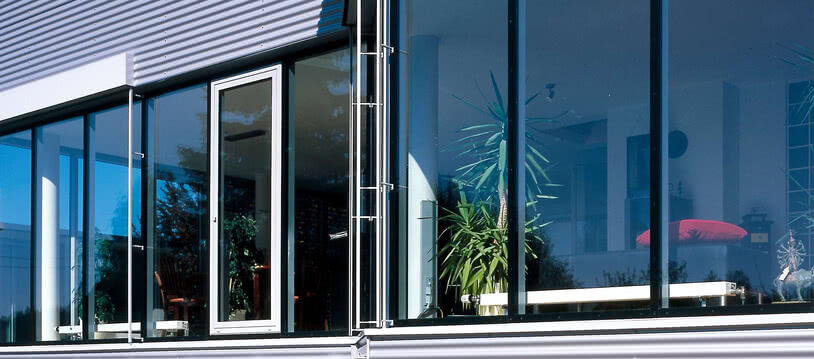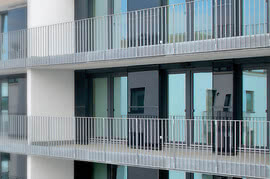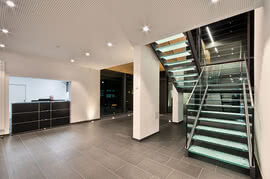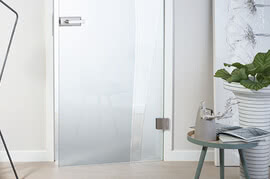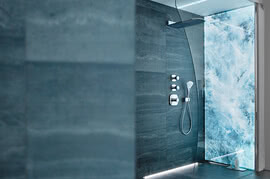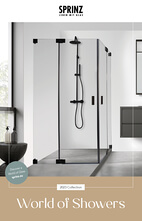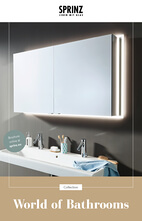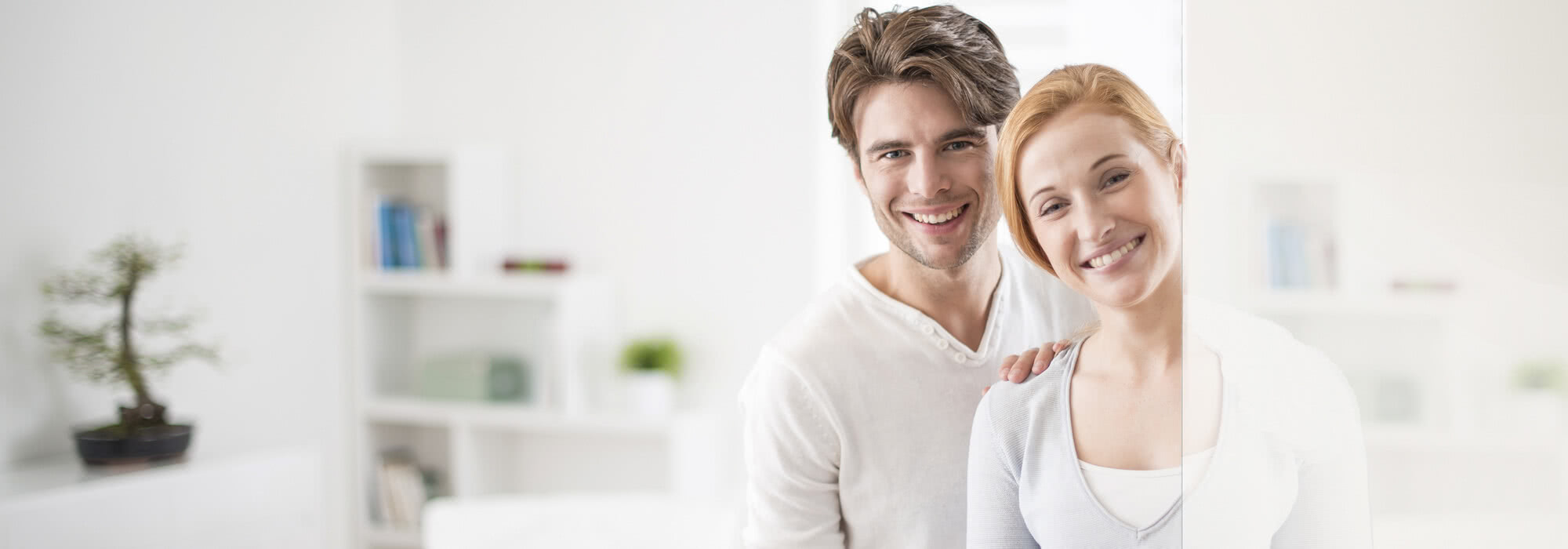
Care advice for our different types of glass and coatings
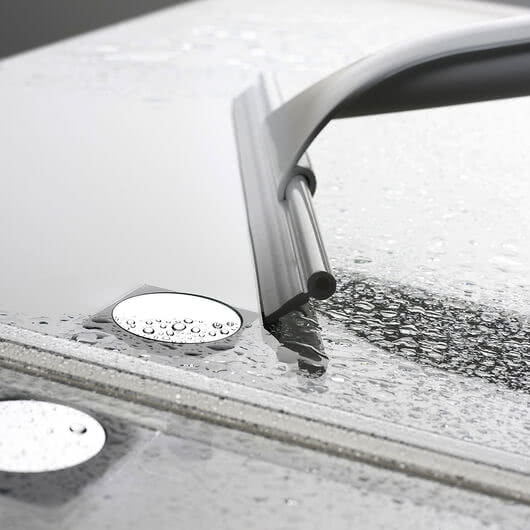
How do I clean my glass?
Care recommendations for different types of glass are as varied and different as the areas of application for our products. Depending on the quality, printing and coating of the glass, there are a variety of tips you should note when cleaning. To give you an overview, we have compiled all the relevant care tips for glass on this page.
How do I clean hard-coated glass?
Persistent stains can be carefully dabbed off with a clean, lint-free cloth, moistened with ethanol. Avoid any excessive pressure and excessive wiping.
After tempering, any hard-coated glass that is installed with the coating facing outwards can be cleaned with a soft cloth and a standard glass cleaner or mild, non-abrasive cleaning product and plenty of water. If there are any solid, abrasive residues, they can be softened up and then carefully removed with water. If you use a squeegee, check it regularly and replace at an early stage to prevent scratches. Make sure its rubber lips are soft and undamaged at all times.
Care tips for hard-coated glass:
- Clean the glass surface with a clean cloth, moistened with ethanol.
- Carefully dab the surface, and avoid any excessive pressure or wiping.
How do I clean tempered safety glass, heat-soaked tempered safety glass and partly prestressed glass?
Remember that, due to the tempering process, tempered glass has a softer surface than non-tempered glass and is therefore far more sensitive. This means that incorrect cleaning can lead to surface damage, such as scratches.
Care tips for tempered glass:
- Clean all surfaces at regular intervals. The older the dirt, the more difficult it is to remove.
- Use a soft, wet sponge or cloth on all surfaces.
- Carefully dab the surface, and avoid any excessive pressure or wiping.
- Only use neutral cleaning products or water.
- Do not use any aggressive cleaning products, cleaners with a high alkaline, chlorine or bleach content or vinegar cleaners, and do not use cleaning products with abrasive substances under any circumstances.
- Do not use a razor blade, a ceramic scraper, steel wool, an abrasive scouring sponge or scouring cream or powder or similar.
How do I clean satinised glass?
Any glass that has been satinised through etching or sandblasting must not be cleaned with cleaning products containing silicone or acid. Chemicals and highly corrosive deposits must be removed with plenty of water straightaway, as they can attack the glass surface. Fatty and oily substances (such as sweat) leave stains with a slight shading effect on satinised surfaces, and such stains cannot always be completely removed with glass cleaner. Instead of a glass cleaner, you can also use water with some spirit added to it. Persistent and lasting marks can be removed with a standard light-coloured pumice sponge, depending on their intensity. Remember, however, to use broad, sweeping movements if possible, applying only slight pressure. Avoid any excessive pressure and lengthy scrubbing in one place, as this will lead to shiny or bare patches. Remove any residues of the pumice sponge with water and a soft microfibre or cotton cloth.
Care tips for satinised glass:
- To clean, use a glass cleaner or water with some spirit added to it.
- Substantial dirt can be removed with a light-coloured pumice sponge, applied with broad, sweeping movements and only a minimum of pressure. Under no circumstances should you use excessive pressure or scrub in one place for long.
- Remove any residues of the pumice sponge with water and a soft cloth.
- Do not use cleaning products containing silicone or acid.
- Any chemicals and highly caustic deposits should be removed straightaway using plenty of water.
- Avoid marks caused by oil, fat, silicone and other highly viscous substances, as they may be difficult or impossible to remove without leaving residues.
How do I clean glass with ceramic digital or screen printing?
The important benefit of glasses printed with ceramic paint is a high level of light resistance, adhesion and durability. Once the paint has been burned onto the glass, it is largely resistant to scratching and chemical impact. We would recommend partial printing (i.e. just stripes or dots), to reduce sensitivity to dirt, as well as using specially developed paints that have been approved by us or a combination of LSG and ceramic print forming a composite.
Environmental conditions and the location and installation situation have a significant impact on how weatherproof the glass is. Depending on air pollution, glass and ceramic surfaces can become unsightly within a few months, due to aggressive substances and exposure to dust. The required amount of cleaning should depend on the degree of dirt.
Care tips for glass with ceramic printing:
- Clean all surfaces at regular intervals. The older the dirt, the more difficult it is to remove.
- Use a soft sponge, chamois leather cloth or squeegee on all surfaces.
- With a damp cloth, proceed in broad, sweeping movements, and apply only slight pressure.
- Do not use aggressive cleaning products or vinegar essence, and under no circumstances should you use products with abrasive substances. If you use a household cleaner, make sure it is suitable for ceramic surfaces.
- Organic dirt can be removed with ethanol, acetone or isopropanol.
- Except for translucent screen printing, any particularly stubborn dirt can be removed with a ceramic hob cleaner. To avoid damage to the surface, apply broad, sweeping movements, with only slight pressure, preferably several times. If possible, first test for toleration and suitability in a less visible place.
- Avoid marks caused by oil, fat, silicone and other highly viscous substances, as they may be difficult or impossible to remove without leaving residues.
- Do not use a razor blade, a ceramic scraper, steel wool, an abrasive scouring sponge or scouring cream or powder.
How do I clean glass with UV printing or varnish?
UV-printed and varnished glass must generally only be cleaned with a clean, soft and slightly damp cloth or sponge. As a cleaning product, we recommend using neutral cleaners only. Puddles should be dried as soon as possible and permanent surface humidity avoided, as both of these might cause (localised) peeling.
Care tips for glass with UV printing or varnish:
- Clean all surfaces at regular intervals. The older the dirt, the more difficult it is to remove.
- Use a soft, wet sponge or cloth on all surfaces.
- When cleaning, apply only slight pressure and use broad, sweeping movements.
- Only use neutral cleaning products or water.
- Do not use aggressive cleaning products or vinegar essence, and under no circumstances should you use products with abrasive substances.
- Puddles should be dried as soon as possible, and permanent surface humidity should be avoided.
- Avoid marks caused by oil, fat, silicone and other highly viscous substances, as they may be difficult or impossible to remove without leaving residues.
- Do not use a razor blade, a ceramic scraper, steel wool, an abrasive scouring sponge or scouring cream or powder.
How do I clean glass with functional SpriClean or SpriMedical coating?
SpriClean and SpriMedical are special coatings for glass in showers and areas with special hygiene requirements, making sanitisation considerably easier and significantly reducing the amount of time spent on product care. The surface should be wiped regularly with a soft cloth, preferably after each use. If the dirt is substantial, it can be removed with a mild standard cleaning product (e.g. neutral or containing no more than 4% vinegar), using a soft cloth or sponge.
Care tips for glass with SpriClean or SpriMedical coatings:
- Clean all surfaces at regular intervals. The older the dirt, the more difficult it is to remove.
- Use a soft, wet sponge or cloth on all surfaces.
- When cleaning, apply only slight pressure and use broad, sweeping movements.
- Only use neutral cleaning products or water.
- Do not use any aggressive cleaning products, cleaners with a high alkaline, chlorine or bleach content or vinegar cleaners, and do not use cleaning products with abrasive substances under any circumstances.
- Do not use a razor blade, a ceramic scraper, steel wool, an abrasive scouring sponge or scouring cream or powder or similar.
FAQs care tips architecture
How often should I clean glass?
The more often you clean your glass, the less time it will take. We therefore recommend cleaning glass at regular intervals.
How can I avoid lime stains and cleaning marks on glass?
To avoid limescale deposits, we would advise using distilled water if you live in a hard water area. If lime stains do occur, use water with a small amount of vinegar added to it and then dry the glass thoroughly. However, do not use paper towels for this purpose, as they contain fibres which would settle on the glass, making it cloudy.
How can I avoid scratches on glass?
Dust particles on the glass can cause scratches if you apply too much pressure when wiping the surface. To prevent this, use a cloth that is as damp and soft as possible.
What are the best products for cleaning glass?
SPRINZ glass is easy to clean, so that mild cleaning products are perfectly adequate. Plain water or a few drops of washing-up liquid are usually enough.
Never use scouring agents, steel wool, cleaning products with abrasive additives or agents containing vinegar, citric acid or any other chemicals, as they may cause damage to the surface.
In addition, also note the special care instructions for different types of glass described on this page.
